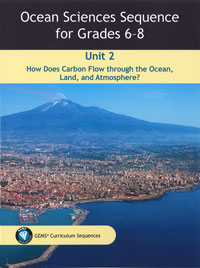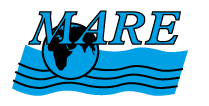Unit 2 Resources
Unit 2: How Does Carbon Flow Through the Ocean, Land, and Atmosphere?
 Session Resources include videos, animations, and simulations that are intended to be used with the curriculum. HTML5 versions of the animations were made possible through funding from the National Marine Sanctuary Foundation, award #16-06-B-00071 Providing More Experience resources are described in the right hand pages of the curriculum and offer excellent supplemental information to support your students' learning.
Session Resources include videos, animations, and simulations that are intended to be used with the curriculum. HTML5 versions of the animations were made possible through funding from the National Marine Sanctuary Foundation, award #16-06-B-00071 Providing More Experience resources are described in the right hand pages of the curriculum and offer excellent supplemental information to support your students' learning.
Session Resources
Session 2.1: Finding Out About Carbon
- Video: It's All About Carbon (Search online for NPR Carbon Video, Episode 1, from NPR.org)
- Providing More Experience video**: Ingredients for Life: Carbon
We recommend using Safari or Firefox as the internet browser to download any video files - Google Chrome may not allow you to download these files. We also recommend that you use QuickTime as your video player.
Session 2.2: Tracking Carbon through Respiration
No resources required
Session 2.3: Tracking Carbon through Photosynthesis, Part 1
Session 2.4: Tracking Carbon through Photosynthesis, Part 2
We recommend using Safari or Firefox as the internet browser to download any video files - Google Chrome may not allow you to download these files. We also recommend that you use QuickTime as your video player.
Session 2.5: Investigating Carbon in the Ocean
Session 2.6: Detecting Decaying and Buried Bodies
- Video: Making Carbon Bonds (Search online for NPR Carbon Video, Episode 2, from NPR.org)
- Video: Rabbit Decomposition
- Providing More Experience video**: Decomposers
We recommend using Safari or Firefox as the internet browser to download any video files - Google Chrome may not allow you to download these files. We also recommend that you use QuickTime as your video player.
Session 2.7: Investigating Combustion and the Carbon Cycle
- Simulation: Interactive Carbon Cycle Diagram (HTML5, new window)
Session 2.8: Crunching the Numbers for the Carbon Cycle
- Simulation: Interactive Carbon Cycle Diagram (Mac)
- Simulation: Interactive Carbon Cycle Diagram (PC)
- Video: Breaking Carbon Bonds (Search online for NPR Carbon Video, Episode 3, from NPR.org)
We recommend using Safari or Firefox as the internet browser to download any video files - Google Chrome may not allow you to download these files. We also recommend that you use QuickTime as your video player.
Session 2.9: Connecting Carbon Flow Changes and the Ocean
- Simulation: Interactive Carbon Cycle Diagram (Mac)
- Simulation: Interactive Carbon Cycle Diagram (PC)
- Video: Carbon in Love (Search online for NPR Carbon Video, Episode 4, from NPR.org)
- Providing More Experience video: The Acid Test
- Ocean Acidification outreach activity. Learners investigate what ocean acidification is, what causes it, and how it affects marine organisms, through a series of hands-on activities, discussions, and short exploration of text.This activity is designed for the general public, and is best accessed by learners in middle school or older. It is best done with small groups.
Resources marked with a "**" are found on the site PBS LearningMedia, which provides educators with strategies, tools, and professional development resources needed to fully utilize digital learning. These are resources that may be freely accessed through their site, although the site requires that you log in after accessing the site a few times. Logging into the site is free, and allows you to search for a wide variety of educational media.
Videos from the NPR site will need to be accessed through their site. Instructions for locating these videos are listed next to their titles below.
All other resources, which are listed in the curriculum's Introduction Book, are also listed at the bottom of this page. We have found these books, DVDs, and websites to be beneficial for additional information on the topics covered in the curriculum.
Back to the top
Resources Listed in the Introduction Book
Books for Students
- The Way Life Works: The Science Lover's Illustrated Guide to How Life Grows, Develops, Reproduces, and Gets Along
Author: Mahlon Hoagland and Bert Dodson
Publisher: Three Rivers Press (November 17, 1998)
Grade Level: 5-10
This incredibly visual book explores several life processes including respiration, photosynthesis and fermentation with clever metaphors and comprehensive explanations.
- Earth (DK Eyewitness Books)
Author: Susanna van Rose
Publisher: DK CHILDREN (April 11, 2005)
Grade Level: 3 and up
In Eyewitness style, this book looks at our planet Earth. It covers topics such as the history of Earth's atmosphere and oceans, modern oceanography and the formation of Earth's geographical features.
- Understanding Photosynthesis with Max Axiom, Super Scientist (Graphic Science series)
Author: Liam O'Donnell
Publisher: Capstone Press; 1st edition (January 1, 2007)
Grade Level: 4 and up
Winner of the 2008 Teachers Choice Award for Childrens Books - Learning Magazine, September 2007
- Carbon-Oxygen and Nitrogen Cycles: Respiration, Photosynthesis, and Decomposition
Author: Rebecca Harman
Publisher: Heinemann-Raintree (October 31, 2005)
Grade Level: 3 and up
Books for Educators
- Our Changing Planet: An Introduction to Earth Science and Global Environmental Change
Author: Mackenzie, F.T.
Publisher: Prentice Hall (2003)
DVDs
- NOVA: Origins
Producer: NOVA
How did the universe become a place that could harbor life? New clues from the frontiers of science are presented by astrophysicist Dr. Neil deGrasse Tyson. With creative graphics, watch how early Earth formed, the creation of the moon, our atmosphere and first life. Purchase, or find it streaming at http://www.pbs.org/wgbh/nova. Search for Origins: How Life Began.
Websites for Students
If you are a fan of Brainpop, there are numerous short clips on many of the concepts introduced in Unit 2.
Use video clips, interactive content pages and quizzes to look at the process of photosynthesis.
The Carbon Cycle Greenhouse Gases Group (CCGG) monitor levels of carbon dioxide and show the information of global trends with interactive models.
National Geographic has created a large, interactive, student-friendly website with many engaging articles and images.
A great interactive website explaining how the ocean is becoming more acidic. The website also includes a simulated lab experience using real data measuring the affects of pH on sea urchin larvae.
Produced by NRDC, this is a great 21-minute film made to raise awareness about the largely unknown problem of ocean acidification, which poses a fundamental challenge to life in the seas and the health of the entire planet.
Created by the National Oceanic and Atmospheric Administration, this site is a small part of the information presented on the ocean and climate. It provides access to video clips, curricula, activities, and further resources.
This playful animation, fun music and pleasant voiceover are engaging and entertaining. The science is handled well.
Websites for Educators
NSTA's Science Objects are two-hour on-line interactive inquiry-based content modules that help teachers better understand the science content they teach. This Science Object is the second of three Science Objects in the Flow of Matter and Energy in Ecosystems SciPack. It explores how the cycling of carbon and other nutrients from non-living to living components and back is one of the most important of ecosystem functions and is representative of the cycling of other elements.
This game-format resource provides students the opportunity to investigate the cycling of carbon through various reservoirs while illustrating the complexity of biogeochemical cycles and conservation of matter.
This website presents issues related to the ocean and climate, such as CO2 emissions, polar melt, ocean currents, and ocean acidification. It also provides a forum for related comments and articles.
An excellent sources of updated information, articles, images, and maps.
A free website for educators, allowing users to access and download resources.
This website from the U.S. Department of Energy and the Lawrence Berkeley National Laboratory provides a selection of short videos that provide concise definitions and explanations about often-complicated topics.




